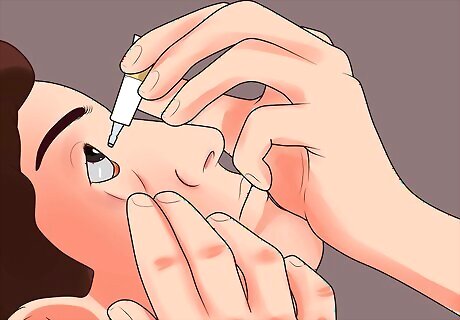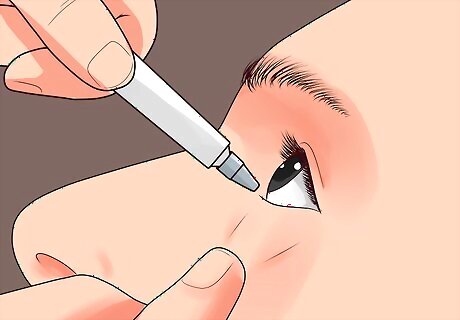
views
X
Research source
Preparing to Use Erythromycin

Educate yourself about the possible side effects. Possible side effects of erythromycin are burning, redness or stinging of the eyes and blurred vision. If these symptoms persist and your condition does not improve, discontinue use of erythromycin and notify your physician as soon as possible. Erythromycin can also cause severe allergic reactions and you should discontinue use immediately if you notice the following symptoms: Rash Hives Swelling Redness Chest tightness Difficulty breathing or wheezing Dizziness or lightheadedness

Consider your medical status and history. Be aware of the contradictions of erythromycin, or the conditions and factors that may be specific to you and require withholding this treatment. Always inform your physician if you are pregnant or have allergies or are currently taking any medications. There are a number of conditions and situations in which you should not use erythromycin. These include: Breastfeeding — Do not use erythromycin ointment while you are breastfeeding. Erythromycin ointment is a category B medication according to FDA regulations and is not expected to harm an unborn fetus. However, the medication may enter the bloodstream of a breastfeeding mother and be transported to the baby via breast milk. Allergy — Avoid using erythromycin if you have a known allergic reaction to it. Inform your physician about any allergic reactions you might expect after using erythromycin. He may either lower the dose or prescribe you with an alternative medicine. Hypersensitivity to erythromycin ointment can be similar to allergy, but to a lesser degree. Certain medications — Taking medications such as Warfarin or Coumadin may cause an interaction with erythromycin ointment. Inform your doctor if you are taking these medications.
Prepare to apply the medication. Remove contact lenses and all eye makeup. Make sure that you have a mirror in front of you so you can see what you're doing or consider having a friend or family member help with application.

Wash your hands. Always ensure that your hands are clean before using the ointment by washing them with soapy water. Washing your hands before touching your face and eyes can help to prevent further infection. Ensure that you wash your hands thoroughly for at least twenty seconds with an emphasis on cleaning the areas in-between your fingers and under your fingernails. Use warm running water and soap.
Applying the Ointment

Tilt your head backward. Tilt your head backwards slightly and then with the fingers of your dominant hand (or whichever you are comfortable with), pull down your lower eyelid. This will create a small pocket where you can insert the medication.

Position the ointment tube. Take the tube of ointment and place the tip of the tube as close as possible over the pocket you created in your lower eyelid. As you do this, you need to roll your eyes upwards, as far away from the tip of the tube as possible. This will lessen the chance that you injure the eye. Do not touch the tip of the tube to the eye. This is important in order to prevent the contamination of the tube’s tip. If the tip is contaminated, this will cause bacteria from the infection to spread more easily and potentially infect other parts of your body or invite a new, secondary infection into your eye. In event of accidental contamination of the tube's tip, rinse the tip thoroughly with sterile water and antibacterial soap. Squeeze the tube to remove surface ointment that may have gotten in contact with the tip.

Apply the ointment. Squeeze a ½-inch long ribbon of ointment (or the amount prescribed by your doctor) into the lower eyelid pocket. While doing this, continue to ensure that you avoid touching the tip of the tube to the surface of your eye.

Look down and close your eyes. As soon as you have applied the right amount of ointment on your eye, look down and close your eyes Roll your eyeball around in its socket with your eyes closed in order to evenly distribute the ointment. Keep your eyes closed for about one to two minutes. This will give your eyes enough time to absorb the medication.

Open your eyes. Use a mirror to check that you have correctly placed the ointment into the eye. Remove any excess ointment with a clean tissue. You may experience some blurriness due to the ointment. As a result, avoid driving or wearing contact lenses after applying the ointment as your vision may be temporarily compromised. You should basically avoid any activity that requires good visual acuity, such as driving or operating heavy machinery. Once your vision has returned to normal, you can resume such activities. Your vision should return to normal after a few minutes. Never rub your eyes even if you have blurred vision. Rubbing will only worsen the blurriness or injure your eye.

Replace and tighten the cap. Store the medication at room temperature, not exceeding 86 degrees Fahrenheit (30 degrees Celsius).
Follow dosing instructions. Know how often you need to apply the ointment and stick to those instructions. Most people have to use the ointment four to six times daily. Set alarms or reminders throughout the day to ensure all doses are met. If you miss a dose, apply the missed dose as soon as you remember it. However, if your next scheduled dosage is coming up, then skip the missed dosage and get back on the schedule. Never apply extra ointment as a way to compensate for a missed dose.

Apply the medication for the prescribed length of time. The duration of erythromycin use can range from a few weeks to six months. Always complete the full course of erythromycin treatment as directed by your doctor. Antibiotics always require their full course of treatment. Though your eye infection may already have healed, you eye may become re-infected if you do not continue to use the medication for the length of time prescribed. A relapse of eye infection can potentially be worse than the initial infection. In addition, not completing the full course of antibiotic treatment runs the risk of developing antibiotic-resistant bacteria, which is an increasing problem for illness requiring antibiotic treatment.

Visit your doctor for a follow-up. After the prescribed length of time of using erythromycin, you can visit your doctor for a follow-up appointment. If you experience any problems or side effects, such as severe itchy watery eyes, you may have an allergy and need to rinse your eyes immediately with sterile water. Have someone take you to an emergency care facility immediately or call 911. If infection still persists after duration of erythromycin as determined by your doctor, inform your doctor. Your doctor may advise using the ointment for a longer period or time or opt for another treatment.


















Comments
0 comment